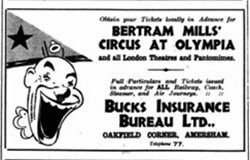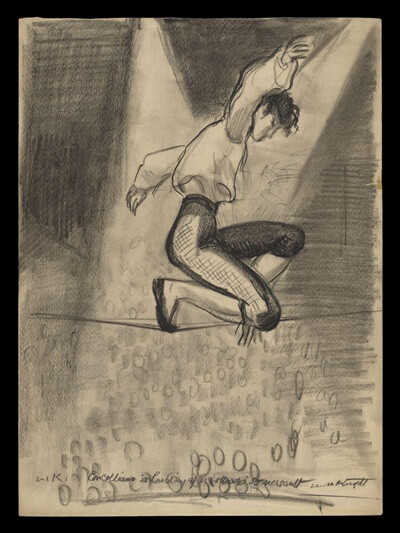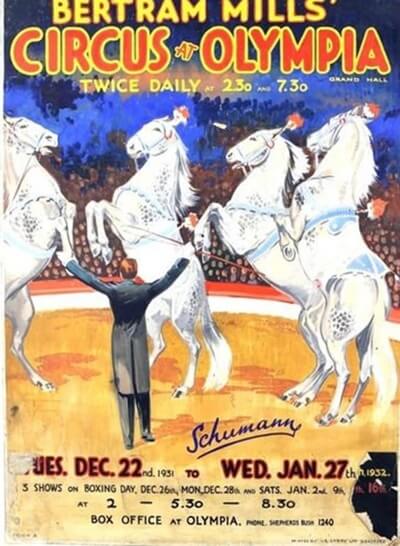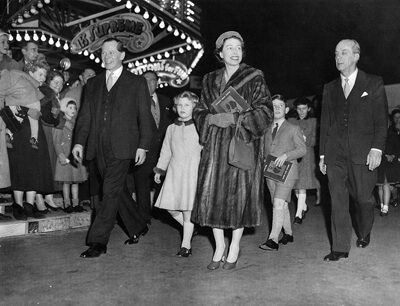Bertram Mills Circus – a Christmas Treat
by Alison Bailey

A favourite Christmas treat for children and adults, for nearly 50 years, was a visit to the Bertram Mills Circus at Olympia. Bertram Wagstaff Mills, known as “the Guv’nor” to his staff, was famous throughout the world. The portrait of him as a dapper gent, with a clipped grey moustache, a cornflower in his buttonhole and a top hat was known to everyone.
Mills’ London address, and the circus’ headquarters was 1 Dorset Square, close to Marylebone station. However, having spent much of his childhood at his family farm, Bottrells, near Chalfont St Giles, the circus impresario’s country home was an Arts & Craft style estate, Pollard’s Wood House, off Nightingales Lane, with extensive stabling and 57 acres for his many horses. Some of the circus animals also stayed at Pollard’s Wood when resting and at the beginning of WWII. Residents still remember the elephants walking in line ‘trunk-to-tail’ from Chalfont and Latimer Station. Whilst this must have caused much excitement amongst the village children it was also popular with local gardeners who would gather with spades at the ready to collect any manure!
Founded in 1920, the Bertram Mills Circus quickly became a household name. By 1930 it was considered the best live show in England and remained so into the 1960s. Members of the Royal family and Winston Churchill were regular visitors at Christmas. Bertram Mills died in 1938, and the running of the circus was taken over by his two sons Cyril and Bernard who continued to build on its success until 1966 when admission figures dwindled and live entertainments such as circuses could no longer compete with television.
The Greatest Showman

Mills, and later his son Cyril, were known for travelling the world to find the best available acts. Their stars were well paid and often stayed with the circus for decades. Performances were held twice daily (with three on Saturday) in the Grand Hall at Olympia from the week before Christmas until late January. Each performance started with the Grand Parade. There was also a funfair, a menagerie of caged wild animals and side attractions such as the Giraffe-Necked Women from Upper Burma, the Oldest Man in the World (reputedly 156!) and Gargantua, an enormous gorilla. All hugely popular then, although problematic for modern audiences.

In Amersham tickets were sold at the Bucks Insurance Bureau at Oakfield Corner. Each year Mills invited thousands of children, many from Amersham and Chesham, to attend the spectacular show. Children and staff from the Chalfont Colony (now the Epilepsy Society) were also given tickets, as were staff from local hospitals and farmers and landowners, who allowed Mills’ beloved Old Berkley Hunt on their land.

From the start Mills understood the importance of advertising and promotion and always enjoyed excellent relationships with national and local papers. This is an article from a local paper in 1938: “There are many wonders this year at Bertram Mills Circus at Olympia, but the wonder of wonders is Koringa, the only woman fakir or Yogi in the world. King Tuffy, the lion, walks a tightrope. Horse and ponies perform human feats. The perch artists include in their turn a man at the top of a thirty-foot pole holding another pole up which a girl member of the troupe climbs and perches herself. The Arthur Family manipulates cycles in a way that makes you think the wheels are part of them. The leader of an acrobatic troupe catapults members of the troupe from the soles of his feet. There is bare-back riding. There are clever cats – cats run up a ladder balanced on a performer’s chin. Of course there is clowning. And it is difficult to know what the circus does not contain. In its eighteenth consecutive season, Bertram Mills’ Circus is a living wonder”.
The circus regularly featured in Pathé News Broadcasts and later on television. Dame Laura Knight (1877-1970) was fascinated by the circus and was a regular visitor to Olympia. She was a founder member of the Circus Fans’ Association and painted The Grand Parade Charivari that was exhibited at the Royal Academy in 1929. That year that she travelled with The Great Carmo Circus that was a partnership between Carmo and Bertram Mills, before Mills launched his own travelling circus. She sketched and painted numerous works featuring acts that were featured in a variety of promotional material for his shows from the early 1930s including invitation cards for the opening day gala luncheon.

Unlike their father, the Mills boys enjoyed a good education at Harrow and Cambridge University. They had careers in oil refinery (Cyril) and estate agency (Bernard), but the excitement of the circus proved too strong, and they both joined their father’s business in the 1920s. When Mills launched his Big Top touring circus in 1930 this was run by his sons. The same strict quality standards were applied with the circus travelling by train in the spring, summer and autumn before returning to Olympia for the festive season.
The beginning

According to the much-publicised story Mills founded the circus by accident. Born in Paddington in 1873, he left school at the age of fourteen to work in his father’s coach building and undertaker’s business. He started at the bottom caring for the horses and washing the coaches, an important form of transportation at that time. During WWI he served in the army reaching the rank of Captain before returning to run the family business.
Mills was passionate about horses, having learnt to ride at Bottrells farm where the company’s horses were rested. He competed in carriage driving, particularly four-in-hand (a coach pulled by four horses) at major horse shows all over Europe, before becoming a prominent judge on the international horse show circuit. A member of Old Berkeley Hunt, he regularly rode to hounds and was a familiar sight at local meets, sometimes driving a vintage carriage from his extensive collection with four black horses.
It was in 1919 that for a £100 wager with his friend, another coach enthusiast, Sir Gilbert Greenhall, that Mills took up the challenge to do better than the circus entertainment they had just seen at Olympia. Mills planned to engage the famous American Circus, Ringling Bros, Barnum and Bailey, but they had to cancel due to the difficulties in shipping a circus across the Atlantic just after WWI. However, Mills was determined to win the bet and decided to go ahead on his own.
His son, Cyril later described the scene at Mills’ home, when Mills revealed to his startled wife, Ethel, and his teenage sons, Cyril and Bernard, that he intended, at the age of 45, to run a circus at Olympia the following Christmas: “His wife protested, “But Bertram, you’ll lose what little money we’ve got! What on earth do you know about circuses?” That first circus, however, was a huge success and Mills won his bet. Cyril continued: “Mother was saved from bankruptcy, and though we were both still schoolboys, we recalled that—well, something pretty stupendous had started in our lives”.
Whilst a great story, Mills was a huge fan of the circus and already knew many acts and circus directors from the international horse show circuit. Despite being invented in England, the circus was not as popular here as in Europe, particularly in Germany, and in America. Mills became known as the saviour of the British Circus, whilst building on the first circus traditions established by Philip Astley, “the father of the Modern circus” in the 18th century. A noted equestrian and former dragoon, Astley and his equally talented wife, started with a trick-riding display in a 42-foot diameter ring in an amphitheatre in Lambeth. They added in clowns, jugglers and other performers and this became the template for the modern circus.
In addition to acts recruited from Europe and America, the Bertram Mills Circus was soon buying its own animals and employing staff. No expense was spared to procure the finest horses including pure and half-bred Arabs, English thoroughbreds, Friesians, Lippizanas, Palominos and Shetland ponies. John Grindl, from Vienna, was employed as the head trainer. He followed Mills’ own philosophy of “patience, understanding and carrots”, beginning at 6am whether in the training ring or at the winter quarters at Ascot. In 1934 Grindl started training six young Burmese elephants that had been purchased from Germany. These were one of the most popular attractions until the last elephant was sold in 1964 when the touring circus stopped operating. Other famous animal trainers included Nikolai Trefonides and his lions, and Armand Guerre and his sea-lions.
Royal Approval

Mills had many influential friends, including the Earl of Lonsdale, who became the honorary president of the circus in 1922. His main role was to preside over a gala luncheon for as many as 1500 on the opening day of the Christmas season. The great and the good, including the Lord Mayor of London, aristocrats, Members of Parliament, and leaders of industry and the arts were invited. Local gentry such as Lord Chesham, the Tyrwhitt-Drakes and Sir John and Lady Dashwood also received invitations. This raised the social status of the circus, making it extremely fashionable amongst society, particularly after the Prince of Wales (the future Duke of Windsor) attended a performance at Olympia in 1926.
Accompanied by his future wife, Wallis Simpson, the prince became a regular visitor to the show’s winter quarters at Ascot, near Windsor Castle. A private box was installed to allow them to meet and to observe the animal training sessions in secret.
The late Queen became a firm fan of the circus after visiting as a child and was the first reigning monarch to visit a circus when she attended the inaugural Royal Performance in 1952 to raise funds for her favourite charities.
A Man of many interests

Mills’ interests and achievements were very varied. He was a Freeman of the City of London, and a Liveryman of the Loriners’ and Farriers’ Company. He served as a member of the London County Council from 1928 until his death, where he served on a range of groups from the Entertainments Licensing Committee to the Wormwood Scrubs Visitors Committee! In the year of his death, he was adopted as a prospective Conservative candidate to represent the Isle of Ely at the Parliament but was most proud of becoming the President of the Showmen’s Guild of Great Britain.
Locally, in addition to his membership of the Old Berkeley Hunt, he was a member of the Conservative and Unionist Association and President of the Princes Risborough Agricultural and Horse Show.
“The show must go on”
Mills died at Pollard’s Wood, 16 April 1938, the day of the Bertram Mills Circus’ season premiere. Cyril and Bernard took over the running of the company, forming with their mother Cyril and Bernard Mills Ltd. The brothers worked well together, each having his own function in the company. Cyril concentrated on the technical aspect, finding new acts, and the programme’s artistic content. Bernard, who like his father was passionate about horses and coaching, took control of the company’s animal acts and trainers, and the administrative side of the business.
The day of his funeral was a day of mourning in Chalfont St Giles. The shops were closed and all the curtains drawn in every house in the village. After the cremation in London, Mills’ remains were carried to the churchyard at St Giles in his best carriage led by his favourite black horses. He left his widow, “the best pal a man ever had” the extraordinary sum of £146,574 (over £10 million today). Ethel Mills sold Pollard’s Wood to the Royal Cancer Hospital (better known today as the Royal Marsden) as a research facility. She moved to Old Timbers in Devonshire Road Amersham although by the 1950s she had let out Old Timbers and moved back to Chalfont St Giles, to Facings in Harewood Road, where she died in 1960.
Sources
Circopedia
https://americanaristocracy.com/houses/pollard-s-wood-house
https://www.elephant.se/location2.php?location_id=838
The Bertram Mills Book of the Circus, Aylwin Robert, 1955
British Newspaper Archive
Ancestry
Bertram Mills Circus: Its Story, Mills Cyril Bertram, 1967

